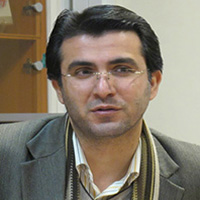The Ethnography of the Process of Bathroom Changes in Tehran
A review of the historical documents and references related to Tehran reveals that this city has been always intrigued by water shortage. In the not-too-distant past, water used to be provided by rivers and uncovered streams that were polluted and contained urban waste. During the recent decades and following the economic development of the country and technological development of water-related industries, several urban plans were executed in different regions of the country, particularly in Tehran as the capital of Iran. These plans led to wide structural changes in the spatial structure of the city. Gradually, these spatial changes led to the cultural development of the residents and immigrants to this city, who became its main residents, such that residents of Tehran have recorded the highest water consumption rate in Iran. The present study shows that taking a bath, which is an essential need and an integral part of the urban and civilized lifestyle today, is a developmental process and its historical course is indicative of the cultural construction of this phenomenon. This construction was reconstructed in a period of contemporary history leading to a critical level of water consumption. Therefore, the authors of this study seek to find an answer to these questions: What changes have the bathroom and taking a bath undergone in their historical course? What are the conditions leading to fundamental changes in washing customs of people? In other words, the present study is an attempt to compare the main structural and cultural features of taking a bath in the past and today, on the one hand, and to examine the structural conditions of mental and cultural changes, on the other hand, to gain a better understanding of the habits and cultural features of the people of Tehran.
The present study was carried out taking a theoretical qualitative approach and drawing on an ethnographic approach. Field studies and participatory observations from 2015 to 2019 were the main sources of data. The study was particularly focused on water consumption and household water use from 2015 to 2018. The data related to the past was also obtained by the historical method. For this purpose, historical texts, travelogues, and images from the past were used. Tourists’ and western politicians’ travelogues such as those of Chardin, Drewville, and Tavernier in the Safavid period were rich sources of data for knowing about the Iranian community and its internal elements such as bathrooms and bathing customs. Written documents and valuable images shared on the cyberspace and the internet as an important part of historical documents related to the spatial structure, architecture of bathrooms and bathing customs and culture in the past were used as the basis of our analysis of the past. The research field included Tehran. To obtain a large volume of information based on the purpose and the questions addressed in the study, two purposeful samplings were made and maximum diversity was used in the group and individual dialogues with two families and 30 citizens of Tehran. This article was written using the authors’ experience of participating in the living environment of the people of Tehran along with in-depth semi-structured interviews with the participants. Brown and Clark’s thematic analysis (2006) was used for analyzing the data obtained via individual and group interviews and field observations.
With the execution of renovation programs in Iran during the last century and the country becoming richer as the result of selling oil, major changes were gradually made possible in the cultural system, on the one hand, and in the psychological drives at the individual level, on the other hand, and people became more civilized. After the reformations made by Reza Shah for centralizing the power, the community became increasingly complicated making public relationships more intertwined and making different social classes growingly interdependent. During these years, consumerism and, consequently, increased water consumption as one of the signs of civilization grew. One of the important functions of bathrooms is to deny and hide one’s primary nature. In other words, the bathroom and bathing in the modern period were accompanied by individualism and the community becoming more civilized.The transformation of the spatial structure of bathrooms and the bathing culture as a consequence of the changes in the water supply system was the predictable result of the renovation process. A review of the history of bathing and bathrooms in Iran reveals that considerable changes have been made from the period of popularity of public bathrooms to the in-house or private bathrooms. In the past, the distance between bathrooms and homes, informal supervision and control, lack of public belief in the need to observe health protocols, financial problems, and technical problems related to water supply made bathing an occasional action with a large time interval in between. The social functions of bathrooms in the form of helping one another in getting washed, massaging, cutting one’s hair, its health and hygiene dimensions, performing religious rites, visiting others, informing others, etc. turned bathrooms into a place very much different from what it is now.In the new era, however, with the development of water supply technologies and improved economic conditions, bathrooms gradually changed into an indoor place with features different from what it used to be. The development of washing facilities and belief in increased access to bathrooms led people to add bathing to their list of daily activities. Bathroom privatization brought about proper hygiene standards. With indoor shower heads being replaced, bathrooms were no longer a place for accumulation of dirt in public bathing pools (referred to as ‘Khazineh’). The growing aesthetic standards by using bathroom tiles of different happy colors on the floor and walls of the bathroom, installing a mirror in the bathroom, designing different functional and luxurious shower heads, bathtubs, lighting, playing music in the bathroom were indicative of the change of the meaning of bathroom and its expected functions in the modern era. Easier access to bathrooms was one of the reasons for the reduced interval between the times of bathing. As the duration of bathing was shortened considering the changes in its traditional functions such as elimination of its social, religious and aesthetic aspects, the spatial structure of bathrooms was modified in a way that it was no longer possible to stay in the bathroom for a long time due to its limited space. Accordingly, the term ‘taking a shower’, which refers to fast bathing in the small space of the bathroom while standing, entered the bathing literature in the contemporary era.Under the conditions, bathing acquired numerous functions. It was a place for getting personal privacy, expression of feelings, crying, laughing, unburdening oneself with water, thinking, singing, refreshment, getting a feeling of peace, cleaning the body and soul. It was also an appropriate space for the appearance of a spiritual sense, focus on one’s body and looking into the mirror, touching one’s body when under the shower and getting the feeling of softness and warmth of the water as an external thing and the appearance of a sexual feeling, development of a better feeling of oneself, improving the sense of unity with oneself, increased self-confidence in interpersonal relationships and civil behavior for avoiding visual and olfactory contamination. All these acquired high significances in becoming civilized.
- حق عضویت دریافتی صرف حمایت از نشریات عضو و نگهداری، تکمیل و توسعه مگیران میشود.
- پرداخت حق اشتراک و دانلود مقالات اجازه بازنشر آن در سایر رسانههای چاپی و دیجیتال را به کاربر نمیدهد.




